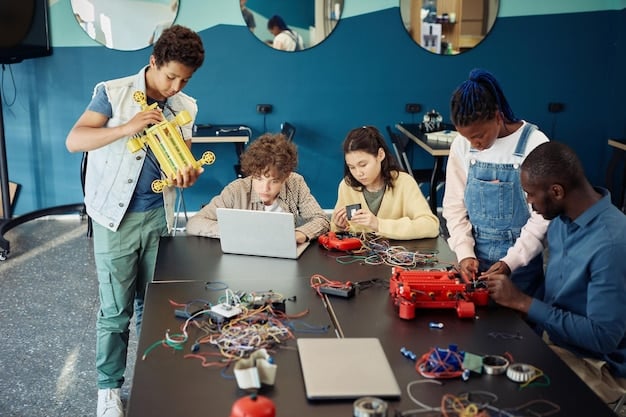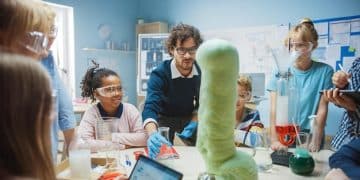New STEM Education Initiatives: Funding & Program Updates for 2025

New initiatives to improve STEM education in 2025 will focus on directing substantial funding towards innovative programs and resources, aiming to enhance both teaching methodologies and student engagement in science, technology, engineering, and mathematics across the United States.
The landscape of STEM (Science, Technology, Engineering, and Mathematics) education is constantly evolving, and 2025 promises to be a year of significant advancements. New initiatives to improve STEM education: Funding and program updates for 2025 are poised to transform how students learn and engage with these critical subjects, preparing them for the challenges and opportunities of the future.
Understanding the Current State of STEM Education in the US
Before diving into the specifics of the new initiatives, it’s crucial to understand the current state of STEM education in the United States. Several factors, including funding disparities, teacher training, and curriculum relevance, contribute to the challenges and opportunities within the field.
The US faces a persistent STEM skills gap, with many industries struggling to find qualified professionals. This gap is particularly pronounced in areas like software engineering, data science, and advanced manufacturing. Addressing this gap requires a multi-faceted approach that starts with strengthening STEM education at the K-12 level.
Key Challenges in STEM Education
One of the primary challenges is the uneven distribution of resources. Schools in wealthier districts often have access to state-of-the-art equipment, well-trained teachers, and robust STEM programs. In contrast, schools in under-resourced communities may struggle to provide even basic STEM education.
- Equity and Access: Ensuring that all students, regardless of their socioeconomic background or geographic location, have access to quality STEM education.
- Teacher Training: Investing in comprehensive professional development for teachers to equip them with the skills and knowledge needed to effectively teach STEM subjects.
- Curriculum Relevance: Designing curricula that are engaging, relevant, and aligned with the needs of the modern workforce.
- Engagement and Interest: Fostering a love of STEM among students, particularly girls and underrepresented minorities, to encourage them to pursue STEM careers.

Addressing these challenges is essential for building a strong STEM pipeline and ensuring that the US remains competitive in the global economy. The new initiatives in 2025 aim to tackle these issues head-on, with a focus on funding, program development, and teacher support.
Overview of New Funding Initiatives for STEM Education
One of the most significant drivers of change in STEM education is funding. In 2025, several new funding initiatives are set to provide much-needed resources to schools and organizations working to improve STEM outcomes. These initiatives are designed to address the funding disparities and support innovative programs.
The increased funding will be allocated to a variety of programs, including teacher training, curriculum development, and the acquisition of new equipment and technology. Additionally, some funds will be directed towards supporting STEM outreach programs that engage students outside of the traditional classroom setting.
Specific Funding Allocations
A significant portion of the funding will be allocated to programs that focus on improving teacher training and professional development. These programs will provide teachers with the skills and knowledge needed to effectively teach STEM subjects and incorporate innovative teaching methods into their classrooms.
Another key area of focus is curriculum development. The funding will support the creation of new, engaging curricula that are aligned with the needs of the modern workforce. These curricula will incorporate hands-on learning experiences, real-world applications, and project-based learning to foster a deeper understanding of STEM concepts.
- Federal Grants: Increased federal funding for STEM education programs through the Department of Education and the National Science Foundation.
- State Initiatives: State-level investments in STEM education, with a focus on addressing the unique needs of each state’s workforce.
- Private Sector Partnerships: Collaborations between businesses and educational institutions to provide funding and resources for STEM programs.
The combined effect of these funding initiatives is expected to be a significant boost to STEM education across the US. By providing schools and organizations with the resources they need, these initiatives will help to close the STEM skills gap and prepare students for the jobs of the future.
Key Program Updates and Enhancements
In addition to increased funding, several key program updates and enhancements are planned for 2025. These updates are designed to improve the effectiveness of STEM education programs and ensure that they are aligned with the needs of students and the workforce.
The program updates will focus on several key areas, including curriculum alignment, teacher support, and student engagement. These updates will be implemented through a combination of policy changes, program revisions, and the introduction of new initiatives.
Curriculum Alignment and Standards
One of the primary goals of the program updates is to align STEM curricula with national and state standards. This alignment will ensure that students are learning the skills and knowledge they need to succeed in STEM fields.
The updated curricula will also incorporate more hands-on learning experiences, real-world applications, and project-based learning. These approaches are designed to make STEM subjects more engaging and relevant for students.

In addition, the program updates will emphasize the importance of interdisciplinary learning. This approach encourages students to connect STEM concepts with other subjects, such as language arts and social studies, to foster a more holistic understanding of the world.
- Next Generation Science Standards (NGSS): Continued adoption and implementation of NGSS to ensure a consistent and rigorous approach to science education.
- Computer Science for All: Expansion of computer science education programs to reach more students, particularly those from underrepresented backgrounds.
- Engineering is Elementary (EiE): Increased integration of engineering concepts into elementary school curricula to introduce students to engineering at an early age.
Focus on Underrepresented Groups in STEM
A critical aspect of the new STEM education initiatives is the focus on increasing the participation of underrepresented groups in STEM fields. This includes women, minorities, and students from low-income backgrounds. Addressing the underrepresentation requires targeted programs and initiatives that promote equity and inclusion.
The efforts to promote equity and inclusion include scholarships, mentorship programs, and outreach initiatives. These programs are designed to provide support and encouragement to students from underrepresented groups, helping them to overcome barriers and pursue STEM careers.
Strategies for Promoting Equity and Inclusion
One of the key strategies is to provide culturally relevant STEM education. This approach recognizes the diverse backgrounds and experiences of students and incorporates these into the curriculum. By making STEM subjects more relevant and relatable, it can increase student engagement and interest.
Another important strategy is to address implicit bias in STEM education. Implicit bias refers to unconscious attitudes and stereotypes that can affect how teachers and students interact. By raising awareness of implicit bias and providing training on how to mitigate its effects, it can create a more inclusive and equitable learning environment.
Additionally, mentorship programs play a vital role in supporting students from underrepresented groups. These programs provide students with access to role models and mentors who can offer guidance, support, and encouragement.
- Targeted Scholarships: Scholarships specifically designed to support women and minorities pursuing STEM degrees.
- Mentorship Programs: Programs that pair students from underrepresented groups with STEM professionals to provide guidance and support.
- Outreach Initiatives: Programs that engage students in STEM activities outside of the classroom, such as science fairs and robotics competitions.
The Role of Technology in Advancing STEM Education
Technology plays a critical role in advancing STEM education. From virtual reality simulations to online learning platforms, technology offers a wide range of tools and resources that can enhance teaching and learning. Integrating technology effectively into STEM education requires careful planning and implementation.
The use of technology in STEM education can help to make subjects more engaging, accessible, and relevant for students. It can also provide teachers with new ways to differentiate instruction and meet the needs of diverse learners.
Innovative Technologies in the Classroom
One of the most promising technologies is virtual reality (VR). VR can create immersive learning experiences that allow students to explore complex concepts in a safe and engaging environment.
Another important technology is online learning platforms. These platforms provide students with access to a wide range of resources, including videos, simulations, and interactive exercises. They can also facilitate collaboration and communication among students and teachers.
In addition, data analytics tools can be used to track student progress and identify areas where they may need additional support. This data can help teachers to tailor their instruction to meet the needs of individual students.
- Virtual Reality (VR): Immersive learning experiences that allow students to explore complex concepts in a safe and engaging environment.
- Online Learning Platforms: Platforms that provide students with access to a wide range of resources, including videos, simulations, and interactive exercises.
- Data Analytics Tools: Tools that track student progress and identify areas where they may need additional support.
Preparing Teachers for the Future of STEM Education
The success of the new STEM education initiatives depends on the preparedness of teachers. Teachers need to be equipped with the skills, knowledge, and resources to effectively teach STEM subjects and inspire students to pursue STEM careers. Investing in teacher training and professional development is essential.
The efforts to prepare teachers for the future of STEM education include professional development workshops, mentoring programs, and access to online resources. These programs are designed to provide teachers with the support they need to stay current with the latest research and best practices in STEM education.
Strategies for Teacher Development
One of the key strategies is to provide teachers with opportunities to collaborate with STEM professionals. These collaborations can help teachers to understand the real-world applications of STEM concepts and incorporate these into their teaching.
Another important strategy is to provide teachers with access to high-quality instructional materials. This includes textbooks, videos, simulations, and interactive exercises that are aligned with national and state standards.
- Professional Development Workshops: Workshops that provide teachers with the skills and knowledge they need to effectively teach STEM subjects.
- Mentoring Programs: Programs that pair new teachers with experienced STEM educators to provide guidance and support.
- Online Resources: Access to online resources, such as videos, simulations, and interactive exercises, that teachers can use in their classrooms.
| Key Point | Brief Description |
|---|---|
| 💰 New Funding | Increased financial support for STEM programs and resources. |
| 👩🏫 Teacher Training | Enhanced professional development for STEM educators. |
| 💻 Tech Integration | Use of VR, online platforms, and data analytics in STEM education. |
| 🙋♀️ Inclusion | Focus on increasing participation of underrepresented groups in STEM. |
Frequently Asked Questions
▼
The primary goals include closing the STEM skills gap, promoting equity and inclusion, and preparing students for the future workforce. Funding will support innovative programs, teacher training, and technology integration.
▼
The funding will be distributed to various programs, including teacher training, curriculum development, and the acquisition of new equipment and technology. Federal, state, and private sector partnerships will contribute.
▼
Technology is crucial, with integration of VR, online learning platforms, and data analytics to enhance teaching and learning experiences. These tools aim to make STEM more engaging and accessible for students.
▼
Initiatives will provide targeted scholarships, mentorship programs, and outreach activities to encourage women, minorities, and low-income students to pursue STEM fields. Culturally relevant education is prioritized.
▼
Teachers will receive professional development workshops, mentoring programs, and access to online resources. Collaboration with STEM professionals will help teachers incorporate real-world applications into their lessons.
Conclusion
The new initiatives to improve STEM education: Funding and program updates for 2025 represent a significant investment in the future of American innovation and competitiveness. By addressing the challenges and opportunities in STEM education, these initiatives aim to prepare students for the jobs of tomorrow and ensure that the US remains a leader in science, technology, engineering, and mathematics.





